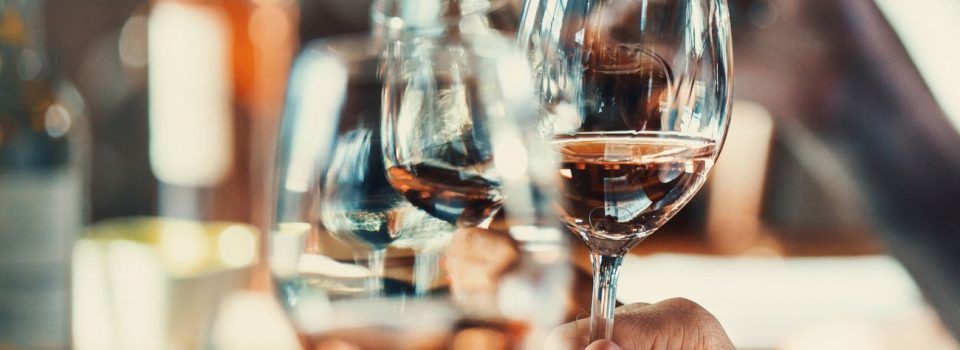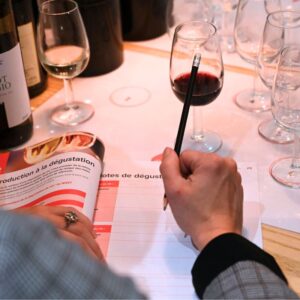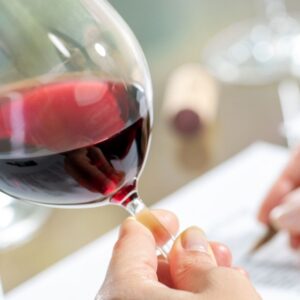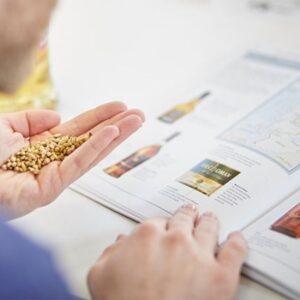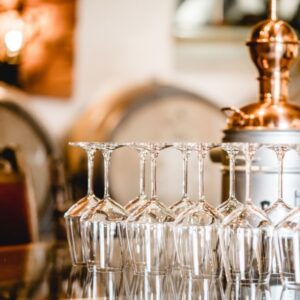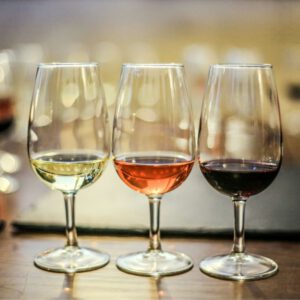Deciding to host a wine tasting at home might seem intimidating at first, but in reality, it’s an exciting and accessible experience, even for beginners.
Whether you’re a curious wine enthusiast or a seasoned connoisseur seeking new discoveries, choosing to host a wine tasting at home is the perfect opportunity to refine your palate and explore a wide range of flavors and aromas. Not only does it provide a fun activity with friends, but it’s also a fantastic way to deeply understand the art of wine tasting and appreciate the richness of wine.
In this article, we’ll guide you through each step of organizing a successful wine tasting, offering practical tips and expert advice. Whether you’re looking for specific wines to taste, methods to structure your event, or recommendations on food and wine pairings, we’ve got everything you need to turn this activity into a memorable experience.
Moreover, as specialists in wine, spirits, sake, and beer training, and WSET-certified, we’ll share our expertise and best practices for hosting a professional wine tasting at home. If you want to go further and perfect your tasting skills, our courses are the next step to becoming a true expert in the world of wine.
Let’s get started and discover how to organize an unforgettable wine tasting at home!
In Part 1 of this article…
Discover how to choose your wine tasting theme at home, how to select your wines, and how to prepare your equipment to organize an unforgettable wine tasting experience!
Click here to read Part 1 and learn how to host a successful wine tasting at home!
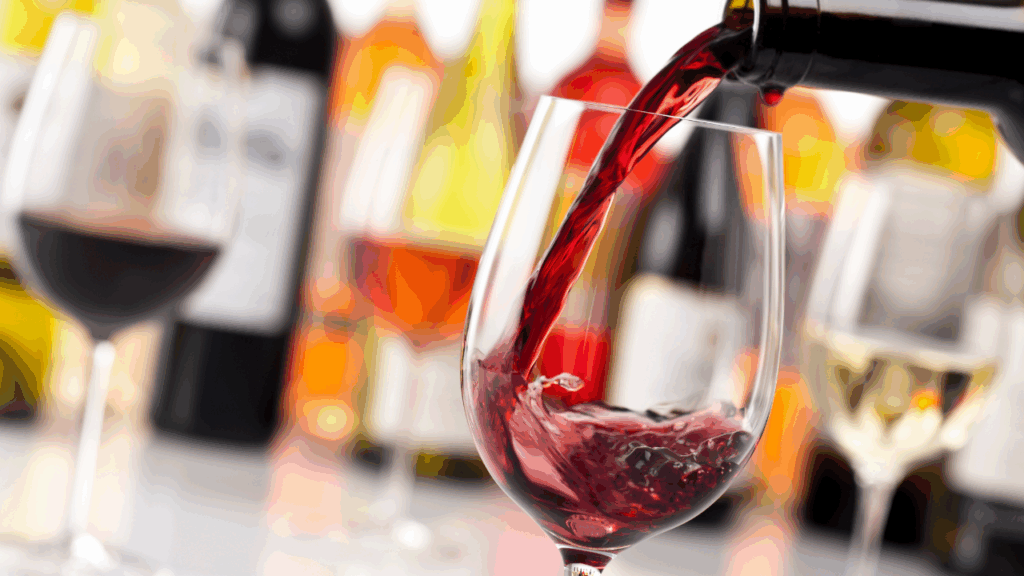
4. How to host a wine tasting at home: structuring the experience
Deciding to host a wine tasting at home successfully doesn’t just depend on the wines you select, but also on how the experience is structured. Good organization helps guide your guests through a smooth and enjoyable sensory journey.
Here’s how to structure your tasting to maximize the experience and keep your guests engaged throughout the event:
1. Welcome the guests and explain the concept
The introduction to the tasting is crucial for setting the tone of the evening.
As soon as your guests arrive, take a few moments to explain the theme of the tasting and how the event will unfold. This not only piques their interest but also helps participants appreciate the wines by giving them clear guidelines.
- Presentation of the theme: Briefly discuss the chosen theme (for example, a regional tasting, a grape variety tasting, or a vertical tasting). Explain why this choice was made and what your guests are going to discover.
- Objective of the tasting: Explain that the goal is to explore, compare, and discuss the wines while refining their sensory perceptions.
2. Present the wines and first observation
Before starting the tasting, briefly present each wine to your guests, but don’t reveal all of its characteristics right away. The idea is to allow them to discover the wine themselves before giving detailed explanations.
- Show the labels: Let your guests examine the bottles, and if possible, provide information about the wine’s origin, grape varieties used, and winemaking techniques.
- Visual observation: Start by visually examining the wine, looking at its color and clarity. This step helps focus on the visual aspects of the wine, which can influence the perception of aromas and taste.
3. Olfaction: smelling the aromas
Olfaction is one of the most important steps in a wine tasting, as approximately 80% of the flavors we perceive come from smell.
Ask your guests to take a moment to breathe deeply and focus on the aromas of the wine. Encourage them to describe what they smell, whether it’s fruity, spicy, floral, or woody.
- First inhale: Encourage a soft first inhale, without putting the nose too deep into the glass to avoid the alcohol masking the aromas.
- Second inhale: After swirling the wine in the glass, invite your guests to take a deeper second inhale to capture the aromas that emerge after aeration.
You can also rely on the WSET systematic tasting sheets to help describe the wines and give your guests the vocabulary to identify the aromas and flavors they perceive.
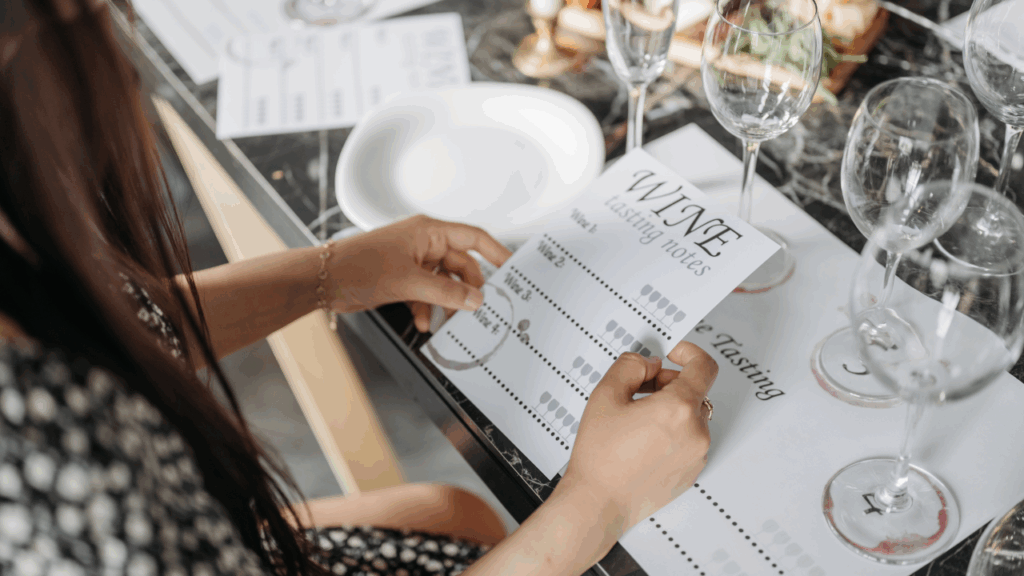
4. Tasting: savoring the wine carefully
Once the aromas have been explored, it’s time to move on to the tasting. At this stage, the goal is to appreciate not only the taste but also the texture of the wine in your mouth.
- Take a small sip: Encourage your guests to take a small sip of wine and roll it around in their mouth to explore its texture. Ask them to note sensations of sweetness, acidity, tannins, and alcohol.
- Identifying flavors: Guests can try to detect specific flavors such as fruitiness, spice, woodiness, or even floral notes. This process helps sharpen their palates and learn how to identify hidden aromas.
- Aftertaste: It’s also important to pay attention to the wine’s aftertaste, known as the “finish”. Is it long or short? The aftertaste is often a good indicator of the wine’s quality.
5. Discussion: sharing impressions
After each wine, give your guests the opportunity to share their impressions. An exchange of ideas will enrich the experience and allow everyone to share their discoveries.
As the organizer, you can ask open-ended questions to guide the conversation, such as:
- “What flavors or aromas did you notice?”
- “How would you compare this wine to the others?”
- “Do you think this wine could pair well with any specific foods?”
This keeps the atmosphere relaxed and friendly while deepening the tasting experience.
6. Move on to the next wine and repeat the steps
Once a wine has been tasted and impressions have been shared, move on to the next wine. Repeat the steps of observation, olfaction, tasting, and discussion for each wine, ensuring the process remains fluid.
- Offer breaks: If you have several wines to taste, propose short breaks between each to avoid palate fatigue. You can also offer crackers or bread to cleanse the palate.
Structuring your wine tasting is essential to make it a smooth and enriching experience when you host a wine tasting at home. By thoughtfully organizing the flow, encouraging discussions, and guiding your guests through each tasting step, you transform a simple event into a true sensory exploration.
Remember that each stage of the tasting is an opportunity to educate your palate and share your passion for wine.
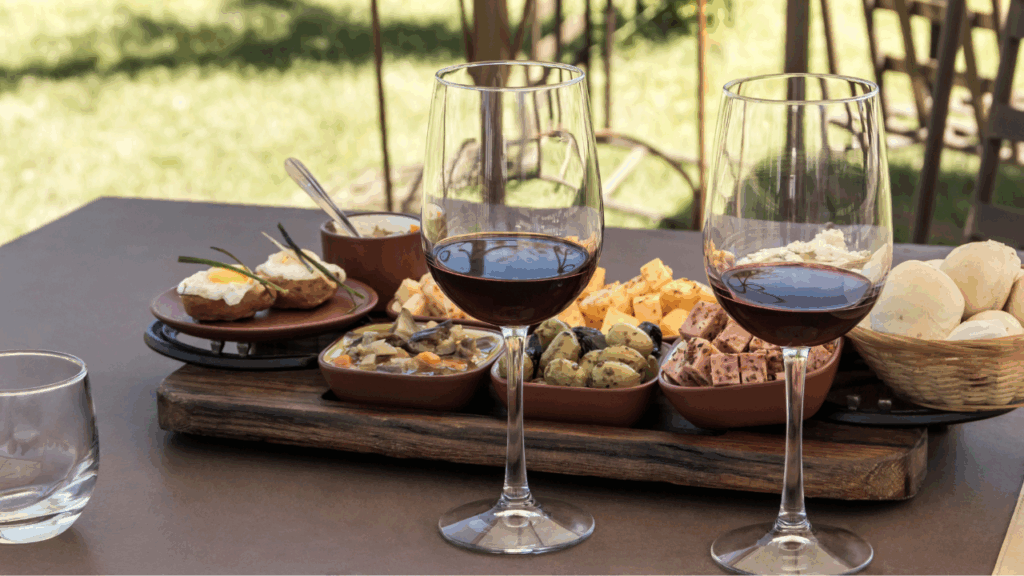
5. Food and wine pairings: elevating flavors
Food and wine pairing is one of the keys to successfully host a wine tasting at home.
When chosen correctly, wines can enhance the flavors of dishes, while the food can bring out subtle nuances in the wines. A good pairing creates a harmony that awakens the taste buds and makes the culinary experience more memorable.
In this section, we’ll give you tips on how to pair your wines with food to elevate their respective flavors:
1. White wines: freshness and elegance
White wines are particularly appreciated for their freshness and lightness. Depending on their style, they can pair perfectly with a variety of dishes, from seafood to cheeses, as well as lighter preparations like salads.
- Dry white wines (Sauvignon Blanc, Chardonnay, Chenin Blanc, etc.):
- Ideal pairings: Seafood, oysters, sushi, grilled fish, green salad, fresh vegetables.
- Why it works: Dry white wines, with their acidity, bring freshness and balance the salty flavors of seafood or light dishes.
- Aromatic white wines (Riesling, Muscat, Viognier, Gewurztraminer):
- Ideal pairings: Spicy food (Indian, Thai), white meats (curry chicken), fresh cheeses.
- Why it works: The aromatic and fruity qualities of these wines pair perfectly with spices while bringing a refreshing balance to rich, spicy dishes.
2. Red wines: power and structure
Red wines, with their fuller body and tannins, are ideal for richer and heartier dishes. The key to pairing reds is finding a dish that can balance or soften their tannic power while highlighting their aromas.
- Light red wines (Pinot Noir, Gamay):
- Ideal pairings: Charcuterie, grilled meats, soft cheeses (Brie, Camembert), lentil salad.
- Why it works: Light, fruity red wines like Pinot Noir offer a softness that complements the flavors of charcuterie and cheeses without overpowering the dishes.
- More tannic red wines (Cabernet Sauvignon, Syrah, Sangiovese, etc.):
- Ideal pairings: Grilled red meats (steak, rib-eye), stews (Boeuf Bourguignon), aged cheeses (Comté, cheddar).
- Why it works: The tannins in Cabernet Sauvignon and Syrah pair perfectly with fatty meats and rich dishes, as they cleanse the palate and balance the richness of the food.
3. Rosé wines: lightness and freshness
Rosé wines are perfect for lighter pairings, thanks to their freshness and moderate acidity. They are ideal for summer dishes or lighter meals, while also offering great versatility.
- Fruity and light rosé wines (Provence, Côtes de Provence):
- Ideal pairings: Composed salads, grilled fish, tapas, tomatoes, couscous.
- Why it works: Fruity and fresh rosé wines add lightness to simple, summery dishes without overwhelming them. They pair perfectly with Mediterranean flavors and fresh vegetables.
4. Sweet wines: elegance and sweetness
Sweet or dessert wines, like Sauternes or Muscat, are perfect for pairing with desserts or sweeter dishes. Their richness and sweetness balance the flavors of sweet foods while adding beautiful complexity.
- Sweet wines (Sauternes, Muscat, Tokaji):
- Ideal pairings: Blue cheeses, foie gras, fruit-based desserts (tarte Tatin, crème brûlée), dark chocolate.
- Why it works: Sweet wines have the richness needed to complement sweet desserts or powerful cheeses, while highlighting the complex flavors of the dish.
5. Food and wine pairings with international cuisine: dare to mix
Food and wine pairings are not limited to French cuisine. For an even more original experience, try pairing your wines with dishes from different cultures. The combination of flavors can surprise and delight your guests.
- Asian cuisine (China, Japan, India): Dry or aromatic white wines pair well with Asian cuisine, particularly with spicy or lightly sweet dishes.
- Mexican cuisine: Fruity and young red wines pair with tacos or spicy meat dishes, bringing refreshing balance to the meal.
Food and wine pairings are a fantastic way to organize a sublime wine tasting and discover unexpected flavor harmonies.
By carefully choosing your wines to complement the dishes, you offer your guests a complete sensory experience that elevates every bite and every sip. Don’t hesitate to be creative and explore different pairings to make your tasting unique and memorable.
If you want to deepen your knowledge of the art of food and wine pairings and gain professional skills to successfully host a wine tasting at home, our WSET courses will provide you with in-depth expertise and internationally recognized certification.
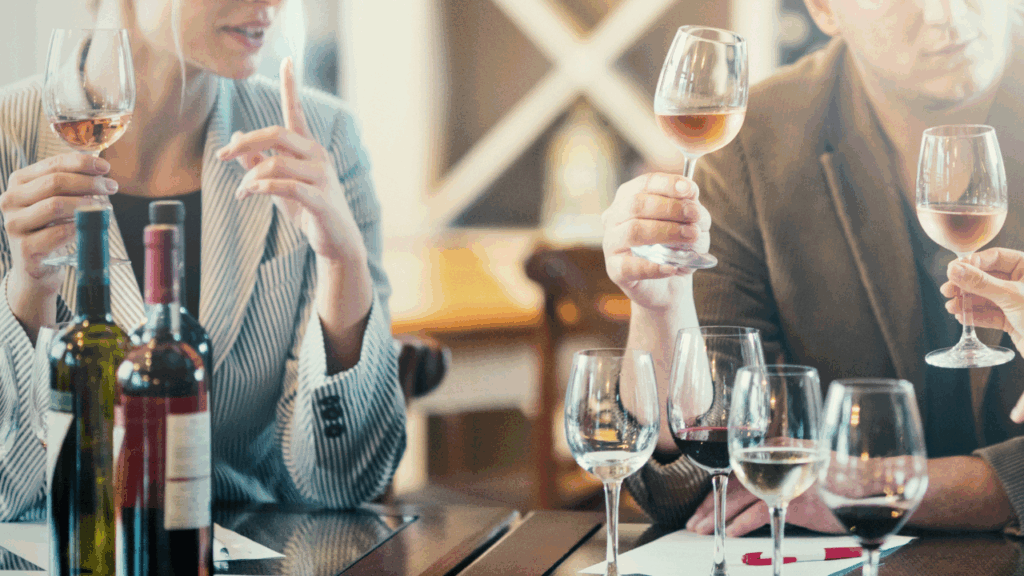
6. Make the difference when you host a wine tasting at home: wine tasting, masterclasses & wine courses
Choosing to host a wine tasting at home is a rewarding experience, but if you want to go beyond the fun and truly master the art of wine tasting, professional training is the key.
A successful wine tasting requires not only a refined palate but also an in-depth understanding of wines, their production, and tasting techniques. This is where wine courses come into play.
Become a wine tasting expert with WSET training
If you are passionate about wine and want to take your knowledge further, earning a professional certification can open many doors. The WSET (Wine & Spirit Education Trust) training is one of the best options for those looking to deepen their knowledge of wine and become true wine experts.
- Globally recognized quality training: WSET is an internationally recognized training provider offering programs suitable for all levels, from beginners to professionals. Whether you’re a wine enthusiast or a professional looking to refine your skills, WSET helps you understand the nuances of wines and learn how to taste them professionally.
- Acquire practical skills: With practical modules on wine tasting, you’ll learn how to identify aromas and flavors, as well as evaluate the quality of wines. You’ll also understand winemaking techniques and how they influence the wine’s flavor profile.
- Recognized certifications: By completing the WSET course, you’ll receive a WSET certification that will distinguish you in the wine world, whether as a sommelier, wine merchant, restaurateur, or simply to enhance your personal experience.
Why should you choose WSET training at Weeno?
At Weeno, we offer high-quality WSET training that is accessible to both wine enthusiasts and professionals.
Here’s why you should choose our courses:
- Clear and structured pedagogical approach: Our instructors are recognized wine experts who know how to communicate their knowledge in a clear and interactive way. Whether you’re a beginner or have some experience, our courses adapt to your level and allow you to learn at your own pace.
- Practical and immersive training: Our sessions include not only theoretical lessons but also practical tastings, allowing you to apply what you learn. The goal is to make you capable of analyzing wine like a professional, identifying its characteristics, and understanding its origins.
- International certification: Upon completing our course, you’ll receive a globally recognized WSET certification. This certification not only helps you deepen your knowledge but also opens up new professional opportunities in the wine industry.
Enhance your tasting experience with professional knowledge
The knowledge gained from a WSET course allows you to add significant value when organizing a wine tasting.
Not only will you be able to recognize different types of wines and better understand their characteristics, but you’ll also know how to guide your guests through a tasting, explaining the nuances of each wine and sharing practical tips on food and wine pairings.
Wine training is more than just theoretical knowledge. It enables you to:
- Learn how to structure a tasting: You will be able to structure a professional tasting, from observation to discussing impressions, including wine evaluation.
- Create perfect food and wine pairings: With a better understanding of wines, you’ll be able to craft harmonious food and wine pairings, surprising your guests with delicious and innovative combinations.
- Analyze and evaluate wines like a professional: You’ll learn how to identify wine defects, assess their quality, and understand their aging potential.
If you decide to host a wine tasting at home, you can offer your guests an enriching and educational experience. However, to go beyond amateurism and become a true wine connoisseur, investing in professional wine training is essential.
The WSET training allows you to not only master the basics of wine tasting but also get professionally certified in an ever-evolving field.
At Weeno, we’re here to guide you every step of the way on this exciting journey.
And if you prefer to stay amateur and host a wine tasting at home…
We also offer oenology courses in Marseille and private classes upon request – perfect for your hen parties, bachelor parties, friends’ gatherings, or corporate events – either at our Marseille location or at your venue.
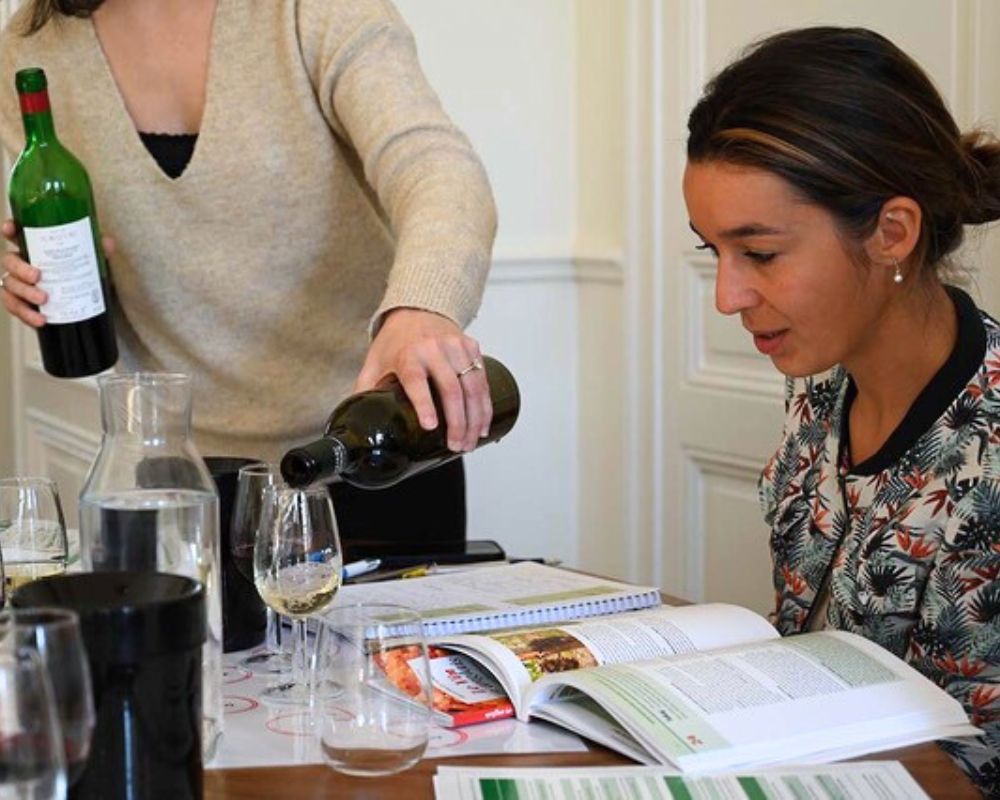
Deciding to host a wine tasting at home is much more than just a social activity: it’s a sensory experience that allows you to discover, appreciate, and understand the subtleties of wines.
By following the steps we’ve shared, from selecting the wines to preparing the equipment and food pairings, you’re now ready to offer your guests an unforgettable evening.
However, if you want to deepen your knowledge and master the art of wine tasting professionally to successfully host a wine tasting at home, a WSET course is the best way to take your skills further.
Through our WSET courses at Weeno, you’ll have the opportunity to develop internationally recognized expertise and distinguish yourself in the world of wine, whether for personal enjoyment or new professional opportunities.
So, why not take the plunge and sign up for a course that will turn your passion for wine into true expertise?
Join our next WSET training session and take a big step toward excellence in the world of wine. For more information and to register, visit weenodrinksacademy.com
